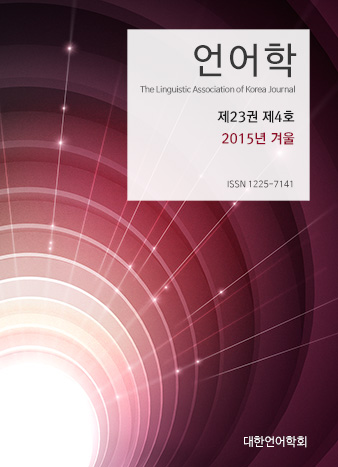대한언어학회 전자저널

23권 4호 (2015년 12월)
Abstract
Amidu, Assibi A. (2015). Remarks on Agreements in Kiswahili Possessive NPs. The Linguistic Association of Korea Journal 23(4), 1-25. Kiswahili has preposition roots (P-roots), such as {a} of', {enye} having and {enye na} having with' which, inter alia, construct possessives. (a) M-toto w-a mw-alimu Cl. 1-child Cl. 1-of Cl. 1-teacher, i.e. teacher's child' is a possessive. It has mtoto as the possessed NP. Its agreement marker {w} is prefixed on the following preposition (P) wa of', whose P-root is {a}. P wa of' is followed by a complement mwalimu teacher', the possessor. (b) M-toto w-a-ke mw-alimu Cl. 1-child of-him/his Cl. 1-teacher, i.e. teacher's child' is called the full pronominal possessive because its P wake his' has the 3rd person singular possessor pronoun agreement marker {ke}. Thus, to signal the possessive, a noun agrees with a nominal P that takes an object N, ±agreement in P. We divide possessive NPs into minimal and maximal types. We point out that whereas the minimal type does not take possessor pronoun agreement, the maximal type can do so. We highlight the relationship of the agreements between prepositions and their Ns in possessive NPs, and reveal that the possessive is not an adjective in Kiswahili.
Keywords
# possessive # preposition # predicate # agreement # pronoun
References
- Amidu, A. A. (2006). Pronouns and pronominalizations in Kiswahili grammar. Köln: Rüdiger Köppe Verlag.
- Amidu, A. A. (2014). A study of non-colonial prepositions in Kiswahili. Linguistic Association of Korea Journal, 22(2), 27-59.
- Ashton, E. O. (1947). Swahili grammar, including intonation (2nd ed.). London: Longman Group Ltd.
- Contini-Morava, E. (2008). Human relationship terms, discourse prominence, and asymmetrical animacy in Swahili. Journal of African Languages and Linguistics, 29(2), 127-171.
- Crystal, D. (2003). A dictionary of linguistics and phonetics (5th ed.). Oxford: Blackwell Publishers Ltd.
- Matthews, P. H. (2007). Oxford concise dictionary of linguistics (2nd ed.). Oxford: Oxford University Press.
- Polomé, E. C. (1967). Swahili language handbook. Washington, D. C.: Center for Applied Linguistics.
- Sacleux, Le P. Ch. C.S.Sp. (1909). Grammaire des dialects Swahilis. Paris: Procure des PP. du Saint-Esprit.
- Sacleux, Le P. Ch. C.S.Sp. (1939). Dictionnaire Swahili-Français. Paris: Institut D'Ethnologie, Place de Trocadero 16e.
- Schadeberg, T. C. (1992). A sketch of Swahili morphology. Køln: Rüdiger Köppe Verlag.
- TUKI and O.U.P. East Africa (2004). Kamusi ya Kiswahili sanifu (2nd ed.). Oxford: Oxford University Press, East Africa Ltd.